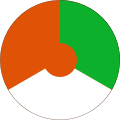 | |
| Use | National flag |
|---|---|
| Proportion | 6:7 (by convention; see below.) |
| Adopted | 23 November 1959 |
| Design | A horizontal tricolour of orange, white and green; charged with an orange circle in the centre. |
The flag of Niger (Hausa : tutar Nijar) has been the national flag of the Republic of the Niger since 1959, a year prior to its formal independence from French West Africa. It uses the national colors of orange, white and green, in equal horizontal bands, with an orange circle in the center. It forms one of the official national symbols of the Republic of the Niger, along with the coat of arms, the National Anthem ("The Honor of the Fatherland"), and the national motto: "Fraternité, Travail, Progrès".
Contents
- Legal definition
- Symbolism
- Ratio
- Historical national flags
- Other flags
- Military flags
- Ethnic group flags
- See also
- Notes
- References
- Further reading















